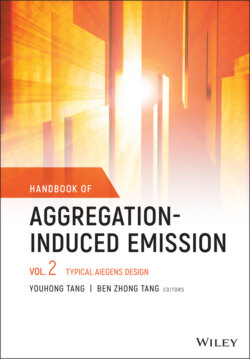Читать книгу Handbook of Aggregation-Induced Emission, Volume 2 - Группа авторов - Страница 20
1.3.3 Chiral Cage for Self‐assembly to Achieve White‐light Emission
ОглавлениеOrganic cage compounds have drawn considerable attention due to their wide functionalities in self‐assembly, gas adsorption, and catalysis, etc [56]. Currently, the organic cages are basically designed based on the classical organic reactions of specific building units. The conjugated units are promising in organic cage design, and the study of optical properties of organic cage is attractive by introduction of these units. However, most of the conjugated units possess ACQ effect. There are few studies on AIE unit‐based organic cages because of lack of AIE prototype structures with good symmetry for design.
As we know, TPP is an AIEgen with four peripheral phenyl rings symmetrically attached to the central pyrazine. Thus, utilization of TPP to develop a luminescent cage is very promising. Tang reported the synthesis of an amphiphilic organic cage with tetrahydroxyl‐substituted TPP (TPP‐4OH) and substituted 2,6‐dichloro‐1,3,5‐triazine (Figure 1.3a) [57]. TPP‐4OH shows very weak emission in the solution due to the vigorous molecular motion under excitation. However, the TPP cage shows a strong emission at 397 nm with a ΦF of 34.3% (Figure 1.3b). Theoretical studies reveal that the rotational energy barrier for the phenyl rings' flipping in the TPP cage is much larger than that in TPP‐OH, which is due to the congested array of each unit in the cage. As the motion of TPP is greatly prohibited in the cage, TPP cage thus exhibits strong emission by suppressing the nonradiative transition. This study also verifies that the restriction of molecular motion is the cause of the AIE effect.
The studies of chirality are closely related to medicinal chemistry and 3D organic electronics. So far, the introduction of a chiral carbon atom into the structure can be regarded as the main source in designing chiral compounds. Interestingly, the TPP cage here also possesses a chirality though no chiral carbon atom is incorporated. Circular dichroism (CD) spectroscopy indicates that a Cotton effect occurs in the absorption regions of the phenyl rings and TPP units in both the solution and aqueous suspensions (Figure 1.3c, d). It is due to the clockwise or anticlockwise rotation of the phenyl rings of TPP against the pyrazine ring caused by the steric effect. Such a special molecular conformation enables it to possess mirror asymmetry to show chirality. Theoretically, the TPP cage with the clockwise or anticlockwise propeller is often obtained in a ratio of 1 : 1 after synthesis, and the resulting racemic mixture should quench the chirality. The reason for inducing chirality awaits further investigation. On the other hand, only a stable right‐handed crystal can be obtained in the air, which shows a positive Cotton effect that originates from the crystallization‐induced asymmetric transformation by destroying the mirror symmetry. Moreover, the CD signals of the TPP cage in the aggregates are much larger than those in the solution, indicative of an aggregation‐induced chirality that has rarely been reported.
Figure 1.3 TPP‐based chiral cage for self‐assembly to achieve white‐light emission. (a) Synthetic route to the TPP cage. (b) PL spectra of TPP‐4OH and TPP cage in THF; their concentration is 50 μM. Inset: their photographs taken under a UV light irradiation. CD spectra of the TPP cage in (c) acetonitrile and (d) acetonitrile/water mixture with a 95% water content; the concentration is 100 μM. (e) Photographs of the TPP cage, DPP, and complex in THF and THF/water taken under a UV light irradiation. (f) Photographs of the complex‐doped PEG film‐casted flashlight during different times and the CIE coordinate of its emission spectra.
Obviously, the TPP cage has a hydrophobic cavity and is potential to capture the guest molecules. Thus, the investigation of its host–guest chemistry is expected. Diketopyrrolopyrrole (DPP) is an ACQ chromophore with a yellow emission in the solution. However, the size of DPP can fit the cavity volume of the TPP cage properly and the supramolecular assembly complex between them can be obtained readily. The successful formation of the complex is proved by the NMR titration and analysis, and the UV–vis spectra indicate a complex ratio of 1 : 1. As DPP has an ACQ effect, its emission is easy to be quenched once aggregated. However, DPP shows a strong yellow emission in the cage even when the complex is in the aggregate state (Figure 1.3e). It demonstrates that the DPP molecules have been isolated by the TPP cage while the π–π stacking has been prohibited to overcome the ACQ effect, therefore providing a flexible strategy to design highly efficient solid‐state luminescent materials with ACQ luminophores. On the other hand, the strong blue emission of the TPP cage sustains. The combined emissions of blue and yellow lights can be observed in the assembly. The emissions of the complex change somewhat from the solution state to the aggregate state. For example, it shows a pink emission in THF. Upon addition of water, the spectrum shifts to white light, which is probably to the subtle variation in emissions of the TPP unit and DPP by changing the microenvironment. Finally, Tang also demonstrates its potential application as white‐light emitters. By doping the complex in the PEG with a weight ratio of 1%, a white‐light‐emissive PEG film can be formed. Further casting the film onto the UV flashlight gives a stable white‐light source for illumination (Figure 1.3f).
